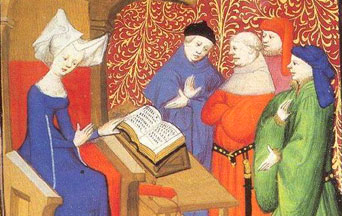
The feminist narrative of history portrays women’s rights as a recent phenomenon. Feminists believe that pre-modern women were oppressed by men and had few rights. Nowhere were women more miserable than in medieval times when the Church and a patriarchal society reduced them to near slavery.
Feminists contend that since then, the fight for women’s rights has made steady and inevitable progress as history evolves to ever greater freedom. We can’t go back, they cry.
Checking the Facts and Chronicles
Maybe the feminists need to go back—and at least look at the facts. Recent studies reveal that this historical perspective is false. Medieval times offered unprecedented opportunities for women. The portrayal of oppressed women is more the invention of modern historians, Victorian distortions and Hollywood scripts than medieval chronicles.
Britain’s The Guardian newspaper reports on two recent works by scholars, Eleanor Janega and Marion Turner. The authors are feminists. However, they studied the chronicles, not the modern journals. They found that women’s lives were much better than previously supposed.
Contrary to popular myths, the authors contend that medieval women were everywhere in society and the economy. They shared many professions, such as brewers, blacksmiths, poets, merchants, master artisans, apothecaries and tailors. They could own land and engage in commerce. Many of these activities were denied to most women before—and even after the Middle Ages.
Eternal and Natural Law: The Foundation of Morals and Law
The authors suggest that modern scholars engage in historical revisionism to make women appear oppressed—often to fit their own narratives or gender studies department agendas.
The Renaissance Rolled Back Women’s Rights
The modern idea of history as an inevitable march evolving toward greater freedom is likewise flawed. If anything, the plight of women has worsened since the Middle Ages. Indeed, the Church elevated the role of women in society. Later secular movements often oppressed them. History does not follow fate but depends upon free will. Thus, periods vary according to the circumstances.
The most surprising finding of the two scholars is that the Renaissance “vastly rolled back the rights of women.” The Renaissance was supposedly a “rebirth” of ancient culture and enlightenment. However, its reborn ideas brought back the neo-pagan Roman and Greek cultures where women had no political rights and limited opportunities.
The Victorian Age also presented a distorted romantic and sentimental idea of women that did not correspond to the reality of their lives. Moreover, the Victorians were obsessed with the Middle Ages and projected their mistaken notions of women upon that historical period. Indeed, the authors consider Victorian women, in many respects, more “socially oppressed” than their medieval counterparts.
Modern and Postmodern Distortions
The distortions compiled over history have found their way into modern and postmodern medieval portrayals. Medieval storytelling, for example, takes non-historical liberties. One narrative, for instance, had a protagonist that was to be married at the “normal” age of 14, when the average medieval woman got married between the ages of 22 and 25.
 Learn All About the Prophecies of Our Lady of Good Success About Our Times
Learn All About the Prophecies of Our Lady of Good Success About Our Times
George Martin, the author of The Game of Thrones, defended his brutal portrayal of the treatment of women in the series, saying, “I wanted my books to be strongly grounded in history and to show what medieval society was like.” Yet there is little evidence to back up this claim.
The fantasy genre of literature also creates medieval-like settings portraying women based on distortions. When scholars find evidence disproving these projections and misconceptions, they are often accused of historical revisionism by the revisionists!
Feminist scholars and fantasy storytellers insist on portraying women as oppressed, despite facts to the contrary.
A True Vision of Society
Thus, most people do not have a proper notion of medieval times since modern ideas are based on a mixture of agendas, distortions and narratives that make it difficult to have a balanced vision of what really happened.
The two feminist authors at least had the honesty to admit the errors around medieval women. However, like most feminists, they are stuck in the Marxist narrative that interprets reality from a class struggle perspective. Their works are filled with the gender jargon and sexuality-centered emphasis, which is unfortunately found in their field. They fail to consider the more spiritual aspects of society that helped determine how society was organized, and women were treated.
Science Confirms: Angels Took the House of Our Lady of Nazareth to Loreto
The Church played a major role in recognizing the inherent dignity of men and women and worked toward the salvation of their souls. At the same time, the Church encouraged the improvement of the material conditions of all, opening up new opportunities for progress. Above all, the Church endowed society with supernatural graces so that men and women became capable of things that took them beyond their human nature.
Any other vision will always be distorted because it lacks some aspects of reality—especially the spiritual and supernatural ones. Rather than seek out the truth, people will project their errors upon the past to make them fit their agenda.

